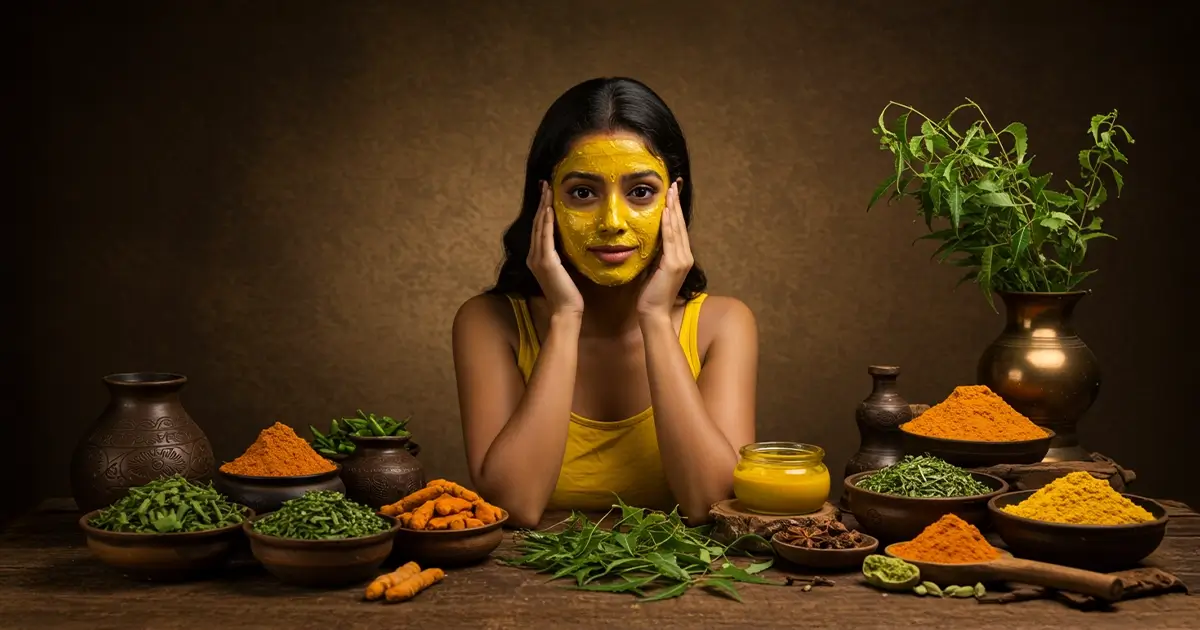If you have ever peered into your spice rack and wondered whether those bright powders and earthy leaves could upgrade more than dinner, today's deep-dive is for you. We will explore how Ayurvedic favourites such as neem and turmeric fit effortlessly into modern routines, and I promise practical tips, balanced science, and a five-minute read that feels like a chat over tea.
Why Ayurveda Still Matters for Modern Skin
I grew up hearing elders say skin mirrors inner wellbeing, and Ayurveda wrote that wisdom down a few thousand years ago. Its herbal catalogue is huge, yet the system's core stays simple: balance heat, moisture, and circulation, then the complexion follows. Translating that into 2025 life means choosing ingredients that calm the daily hustle's irritation before it shows up as redness.
Instead of rigid rules, Ayurveda offers guiding principles: use cooling herbs when skin feels angry, warming spices when circulation seems sluggish, and gentle plant oils to keep barriers resilient. This flexibility lets us mix ancestral insight with evidence-based dermatology, and it explains why clinics now study neem extracts next to synthetic actives.
Modern labs love data, so they test these botanicals under microscopes rather than moonlight. Neem demonstrates antibacterial force against Propionibacterium acnes, while curcumin in turmeric reduces inflammatory markers comparable to mild topical steroids, according to a 2024 review in the Journal of Cosmetic Dermatology. When tradition and peer-review begin to rhyme, my curiosity spikes.
Another reason Ayurveda resonates is ecological. Many of the herbs come from drought-tolerant trees or low-input crops, meaning a lower environmental footprint than exotic synthetics that demand heavy processing. Choosing them can be a small climate-smart gesture packaged inside your cleanser bottle.
Finally, the sensory experience is joyful. Grinding leaves, whisking pastes, and inhaling earthy aromas turns a rushed regimen into a mini ritual. Rituals slow us down, and slower skincare habits often translate into gentler application and better absorption. Skin likes patience as much as peptide serums.
Neem: The Purifying Powerhouse
Neem, or Azadirachta indica, earns its superhero cape from a cocktail of nimbin, azadirachtin, and quercetin. These compounds tackle bacteria, fungi, and oxidative stress in one sweep. A 2023 paper in the Indian Journal of Dermatology highlighted neem oil's ability to reduce lesion counts in mild acne without notable irritation. That is impressive considering many over-the-counter spot treatments still sting like fresh lemon juice.
The tree's bark, leaves, and seeds are all medicinal, but leaf extract leads the cosmetic charts because it balances potency with safety. Manufacturers standardise it to about two per cent azadirachtin for leave-on formulas, which keeps efficacy high while lowering the chance of contact dermatitis.
Now, here is the fun part: neem blends happily with other ingredients. Pair it with niacinamide for an extra anti-inflammatory punch, or with gentle alpha-hydroxy acids to sweep away debris the herb has detached from pores. Just avoid mixing neem oil with full-strength retinoids at the same application; both are powerful and might overtax sensitive skin.
How to Use Neem Daily
- Add one drop of cold-pressed neem oil to a ten-cent-coin-sized pool of your gel cleanser at night, massage for sixty seconds, then rinse.
- Steep five dried neem leaves in 200 ml hot water, cool, and spritz as a clarifying facial mist for midday shine control.
- Blend two teaspoons of neem powder with plain yoghurt for a weekly two-minute mask if breakouts lurk along the jaw.
- Dot a ready-made neem serum on ingrown-prone areas after shaving to minimise bumps.
- For scalp care, mix five drops into your shampoo palm; dandruff often calms within a fortnight.
If you worry about the distinct herbal aroma, remember it fades once moisturiser layers on top. Besides, friends will notice your clearer T-zone long before they sniff lingering leaves. That is a trade-off I am happy to make.
Safety-wise, patch testing is non-negotiable. Apply a diluted drop behind the ear, wait twenty-four hours, then proceed if irritation stays absent. People allergic to nuts or garlic occasionally cross-react with neem, so listen to your skin rather than internet hype.
Still unsure? Dermatologists now carry over-the-counter neem gels in clinic dispensaries, which shows how mainstream the leaf has become. If professionals find room next to benzoyl peroxide, it deserves a cameo in your bathroom cabinet too.
Turmeric: The Brightening Guardian
Turmeric's sunny pigment comes from curcumin, a polyphenol with antioxidant effects strong enough to survive hot curries and still fight free radicals. The only thing quicker than a sneeze after sniffing black pepper is how fast turmeric can stain a white towel, so wear an old T-shirt when experimenting.
In topical studies, curcumin has reduced ultraviolet-induced photo-damage by neutralising reactive oxygen species. Scientists at Mayo Clinic note its systemic anti-inflammatory potential, which may help conditions involving chronic redness when taken judiciously as a supplement.
Many brightening products chase melanin production aggressively, sometimes leaving skin barrier compromised. Curcumin works smarter: it down-regulates tyrosinase without stripping lipids, so dullness fades while softness stays. A 2024 Verywell Health report summarised new trials showing noticeable tone evening within eight weeks of consistent use for mild hyperpigmentation.
DIY Turmeric Honey Mask
- Mix half a teaspoon of ground turmeric with one tablespoon raw honey and one teaspoon oat flour.
- Apply a thin layer to clean skin, avoiding eyebrows unless you fancy a golden unibrow.
- Wait ten minutes, then rinse with lukewarm water and follow with unscented moisturiser.
- Repeat twice a week. If staining worries you, add a splash of milk to dilute the pigment.
- Store leftover paste in the fridge for three days max; after that, compost it.
For ready-made options, look for encapsulated curcumin at two to three per cent, which improves stability and lowers the risk of yellow residue in pores. Encapsulation also protects curcumin from light degradation long enough for you to finish the jar.
Layering matters here as well. Apply turmeric serums after watery essences and before thicker creams. If you love sunscreen - and I hope you do - its zinc particles can slightly mute turmeric's tint on the skin surface.
Turmeric supplements seem tempting, yet dosage controls are essential. Most studies use 500 mg curcumin with piperine to enhance absorption, taken with a meal. Exceeding that can upset digestion or interact with blood thinners, so chat with a pharmacist before adding capsules to your cart.
Other Ayurvedic Herbs Worth Trying
While neem and turmeric steal the spotlight, Ayurveda's supporting cast deserves applause too. Manjistha, a crimson root, is prized for circulatory support that shows up as clearer, more even tone. Early lab studies suggest its flavonoids can inhibit tyrosinase, the same enzyme vitamin C targets, so manjistha feels like a botanical cousin to your brightening serum.
Tulsi, sometimes called holy basil, is another all-rounder. Its eugenol content offers antioxidant protection similar to green tea, while ursolic acid supports collagen integrity. When my skin feels stressed after a deadline sprint, a tulsi steam calms both pores and mind.
Amla, the Indian gooseberry, is famous for vitamin C density that clocks in higher than orange juice per gram. Applied topically in low concentrations, amla extract helps fend off free radicals generated by pollution particles. Oral powder added to smoothies also supports collagen synthesis from the inside.
Gotu kola may ring a bell if you have used centella creams from Korean brands. Ayurveda has applied this marsh plant for wound healing long before it became TikTok trendy. The triterpenoids asiaticoside and madecassoside encourage fibroblast activity, helping fragile skin bounce back after over-exfoliation.
Different herbs shine in different roles, yet they play well together. Manjistha pairs with turmeric for brightening masks, tulsi matches neem in clarifying toners, and amla smoothies complement topical vitamin C. This buffet approach lets you tailor care to seasons, moods, and hormonal cycles instead of following a rigid prescription.
Pairing Ideas at a Glance
- Manjistha + turmeric night mask for post-blemish marks.
- Tulsi + neem toner to keep T-zone balanced during summer.
- Amla oral powder with morning oat milk for antioxidant support.
- Gotu kola cream layered under sunscreen when barrier feels thin.
Blending Herbs Safely with Your Current Routine
A skincare shelf has limited real estate, so integrating new herbs requires strategy. Start by mapping morning and evening lineups on paper, identify steps where irritation shows, then swap in botanical alternatives rather than stacking products like Lego bricks.
For oily skin, replace the midday alcohol-based toner with a neem hydrosol. Dry skin types might fold turmeric oil into their night cream instead of adding another serum. Tailoring placements prevents redundancy and keeps wallets happier.
Interaction checks protect progress. Neem's limonoids can potentiate certain actives, so avoid applying it in the same minute as alpha-hydroxy acids above ten per cent. Turmeric may slightly lower pH locally, which works fine for vitamin C but could destabilise peptides. Leave a five-minute buffer when uncertain.
Tracking results will beat guessing. Use your phone camera weekly under the same bathroom light, then compare. Subtle improvement is easy to miss day to day, and photos reveal whether that stubborn forehead patch finally chilled out.
Quick Checklist Before Mixing
- Patch test each herb in the exact formulation strength you plan to use.
- Introduce only one new product every seven days to isolate reactions.
- Keep an antihistamine on standby if you have a history of plant allergies.
- Document texture, scent, and expiry dates; natural products degrade faster.
If you crave further guidance on layering, peek at my earlier piece on the K-Beauty Ten-Step Routine where I map sequence logic in more detail. Watching how different systems align can spark fresh ideas.
FAQ
Can neem cure acne completely?
Neem lowers bacterial count and inflammation, which helps acne, but it cannot override genetics, hormones, or diet. Think of it as a supportive co-pilot rather than the entire flight crew.
Will turmeric stain fair skin long-term?
The yellow tint binds loosely to dead cells and washes off with gentle cleanser. A thin application, followed by sunscreen, prevents any build-up on fair complexions.
Is it safe to ingest neem capsules?
Short courses under professional supervision appear safe for adults, yet high doses may affect liver enzymes. Always consult a qualified practitioner before oral use, especially if pregnant.
How soon can I expect visible results?
Mild blemish reduction can appear in two weeks with neem, while turmeric's brightening effect typically needs six to eight weeks of consistent application.
Can I use both herbs in one recipe?
Yes, but start with lower concentrations. For instance, half a teaspoon turmeric powder with one teaspoon neem powder in a yoghurt base offers synergy without overwhelming skin.
Are these herbs vegan and cruelty-free?
Pure plant powders are inherently vegan. Confirm the final product's certification to ensure no animal-derived stabilisers or animal testing occurred in manufacturing.
Conclusion
Neem and turmeric bridge ancient wisdom and modern evidence, offering gentle antimicrobial action, anti-inflammatory support, and a sensory boost that turns routines into rituals.
Experiment mindfully, observe your skin's feedback, and you may find these herbs become steady companions on your journey to resilient, comfortable complexion. See you in the next post - until then, take good care of your skin!


Comments (0)
No comments yet - be the first to share your thoughts!
Leave a Reply
Your email address will not be published. Required fields are marked *